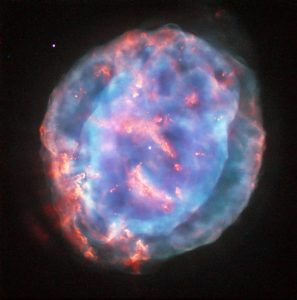Hubble trova una piccola gemma

Questa bolla colorata è una nebulosa planetaria chiamata NGC 6818, conosciuta anche come Nebulosa Piccola Gemma (Little Gem Nebula).
Si trova nella costellazione del Sagittario, a circa 6.000 anni luce di distanza da noi. Il prezioso bagliore della nube si estende per poco più di mezzo anno luce, gigantesco rispetto alla sua piccola stella centrale, ma ancora un piccolo gioiello su scala cosmica.
Quando le stelle come il Sole vanno in “pensione”, espellono i loro strati esterni nello spazio fino a creare nubi di gas incandescente chiamate nebulose planetarie. Questa espulsione di massa non è uniforme, e le nebulose planetarie possono avere forme molto complesse. NGC 6818 mostra nodose strutture simili a filamenti e strati distinti di materiale, con una bolla centrale brillante e delimitata, circondata da una nube diffusa più grande.
Gli astronomi ritengono che un veloce vento stellare, spinto dalla radiazione proveniente dalla calda stella centrale, stia creando la forma allungata della nebulosa.
[ Barbara Bubbi ]
https://www.nasa.gov/image-feature/goddard/hubble-finds-a-little-gem
Image credit: ESA/Hubble & NASA
Lascia un commento